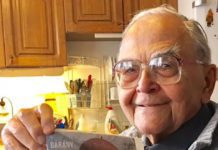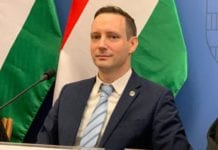By BosNewsLife News Center in Budapest
BUDAPEST, HUNGARY (BosNewsLife)– Thousands of Hungarians have participated in the ‘March of the Living’ to commemorate the victims of the Holocaust, shortly after the remains of about 20 executed people, most of them Ashkenazi Jews, were buried in Budapest’s Jewish cemetery.
For the first time, leaders of Hungary’s main churches addressed the crowds during the annual event, also viewed as Hungary’s largest anti-racist rally.
“It is a historic moment, when the leaders of the Christian and the Jewish religion are on the same stage together,” said Gábor Gordon, the head of the March of the Living Hungary Foundation.
The March, held for the 14th time, began at the Dohány Street Synagogue and made its way to the nearby St. Stephen’s Basilica.
Chief Rabbi Róbert Frölich said that although the Synagogue, Europe’s largest, and the Basilica are just a few minutes’ walk apart, “there were times when the sobbing of the Synagogue and the cries for help from Jews who were to be sent to die fell on deaf ears and closed doors.”
CONFRONTING PAST
Catholic Bishop János Székely, who heads the Christian-Jewish Council, stressed however that “we must take the steps of the March of the Living in our hearts” by confronting the past and getting to know, love and respect other cultures and people.
He noted that Orthodox rabbis have urged Christians and Jews to work together on resolving the world’s moral challenges and the making the planet a better place.
Yet, Bishop István Szabó Bogárdi, of the synod of the Hungarian Reformed Church, said that while walking in the March today, “one should think about those who could also walk the same streets with their grandchildren today” had they not been “thrown for no reason into the hell of war” as innocent victims.
 Similar words resonated during an earlier ceremony involving some 200 people, including a Hungarian government minister and members of the Christian clergy, attending a historic Jewish funeral ceremony.
Similar words resonated during an earlier ceremony involving some 200 people, including a Hungarian government minister and members of the Christian clergy, attending a historic Jewish funeral ceremony.
For the first time in decades, representatives of Hungarian Jews laid to rest hundreds of bone fragments, some showing bullet holes, in two wooden caskets.
HOLOCAUST VICTIMS
Authorities believe that the bones belonged to Holocaust victims killed by the Hungarian Arrow Cross in late 1944 or early 1945. The pro-Nazi group executed thousands on the banks of the Danube River near the end of World War Two.
The remains of were found during the renovation of Margit Bridge in 2011, when divers spotted the bones wedged around a pillar. Preliminary examinations indicated they belonged to around 20 different people, including women and children. Last August, an anthropology student ran DNA tests on the fragments and concluded that most samples were almost certainly from European Ashkenazi Jews.

“I remember it like it was yesterday,” said Rabbi Péter Kardos, who was 8 years old when he survived the mass shootings near the the Danube River. “There were hundreds of us lined up by the river, then we heard an order that those with children should leave, so my mother took my brother and me away,” he said. “We were lucky as they didn’t shoot children that day for some reason.”
The funeral came after some Jewish groups accused the rightwing government of Viktor Orbán of trying to downplay Hungary’s role in the Holocaust. They refer to a government-backed Holocaust memorial statue in Budapest which critics say does not acknowledge Hungary’s willing participation in the deportation of hundreds of thousands of Jewish people in 1944.
The memorial features the Nazi imperial eagle swooping down on the angel Gabriel, symbolically depicting Hungary as the victim of German aggression. But Budapest was allied with Berlin well into 1944, when the Nazis invaded and occupied the country to prevent it from striking a separate peace agreement with the Allies.
FIRST BURIAL
András Heisler, head of the Federation of Hungarian Jewish Communities, said Friday’s burial was “the first and only case in 70 years” that bones believed to be of Hungarian Holocaust victims had been found and buried.
“This burial is a very important moment in the processing of these events,” Heisler said, adding that he hopes “Hungarian Jews could break away from the position of victims they have been in for 70 years and move in the direction of progress and building the future.” In total some 600,000 Hungarian Jews died in the Holocaust.
Back at the March of the Living, Lutheran Bishop Péter Gáncs asked God’s blessing on the marchers who he said “should be caretakers and the advocates of human life”.
Among the main speakers was also Géza Röhrig, the lead actor in Lászlo Nemes Jeles’ Academy Award-winning film, Son of Saul. Röhrig said the Holocaust and the Auschwitz death camp fundamentally changed human norms in two distinct ways.
“For one, it brought to the surface the horrific acts humans are capable of committing against one another. Secondly, it demonstrated how far God allowed people to go in their actions without intervening,” he said.
GOD’S IMAGE
“Our perceived images of ourselves and God changed forever. Auschwitz is to history what the theory of relativity is to science: nobody understands it, but it affects everyone,” Röhrig said.
Israeli Ambassador Ilan Mor said the most important message of the March is that “being different is not an illness, and hatred against someone else cannot be a cure.” Democracy today ensures in society not only equal rights, but also the right to be different, the diplomat stressed.
The marchers paid tribute to Nobel laureate Hungarian writer Imre Kertész, a Holocaust survivor, who died on March 31 at age 86.
Elsewhere in Budapest people gathered to unveil a memorial statue to some 100,000 forced laborers during World War II. The monument in the capital’s 8th District, which had a large Jewish population before the Holocaust, was created by Hungarian-Israeli artist Dan Reisinger.
Hungary’s government and the Hungarian Ministry of Defense supported the statue.
(With reporting by BosNewsLife’s Stefan J. Bos in Budapest, Hungary).








